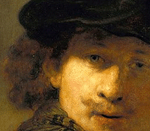
"Illustration for Milton's Paradise Lost"
Paul Gustave Louis Christophe Doré ( 6 January 1832 – 23 January 1883) was a French printmaker, illustrator, painter, comics artist, caricaturist, and sculptor. He is best known for his prolific output of wood-engravings illustrating classic literature, especially those for the Vulgate Bible and Dante's Divine Comedy. He created over 10,000 illustrations, the most important of which were copied using an electrotype process using cylinder presses, allowing very large print runs to be published simultaneously in many countries. Doré won commissions to depict scenes from books by Cervantes, Rabelais, Balzac, Milton, and Dante. Doré's illustrations for the Bible (1866) were a great success. Doré's later work included illustrations for new editions of Coleridge's Rime of the Ancient Mariner, Milton's Paradise Lost, Tennyson's Idylls of the King, The Works of Thomas Hood, and The Divine Comedy.
Paradise Lost is a dramatic retelling of the Biblical story of Humanity's fall from grace as a result of Adam and Eve's disobedience to God. It adds many dramatic elements to the traditional story, of the author's own invention, including a background story depicting the war between the Fallen Angels and God, and explaining why Satan and the other devils sought to bring about the fall of man by tempting and deceiving the first humans into breaking God's rules. As a result of eating the fruit from the forbidden Tree of Knowledge, Adam and Eve and all their descendents lose their place in Paradise (The original Garden of Eden) and are forced to live a life of pain and toil in a depleted earth, which is but a shadow of the abundant garden that they once enjoyed. As with Dore's illustrations for other classic works such as Don Quixote, the Bible and and Dante's Divine Comedy, his illustrations for Paradise Lost are noted for their powerful imagery and their ability to capture and bring to life the essence of the text.